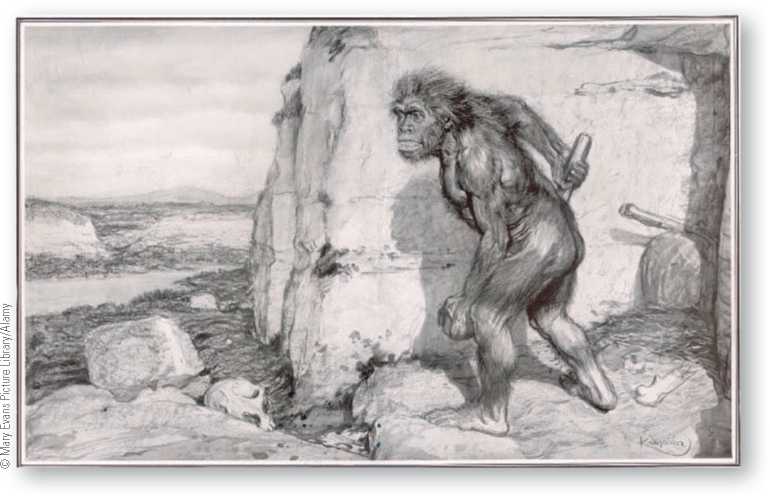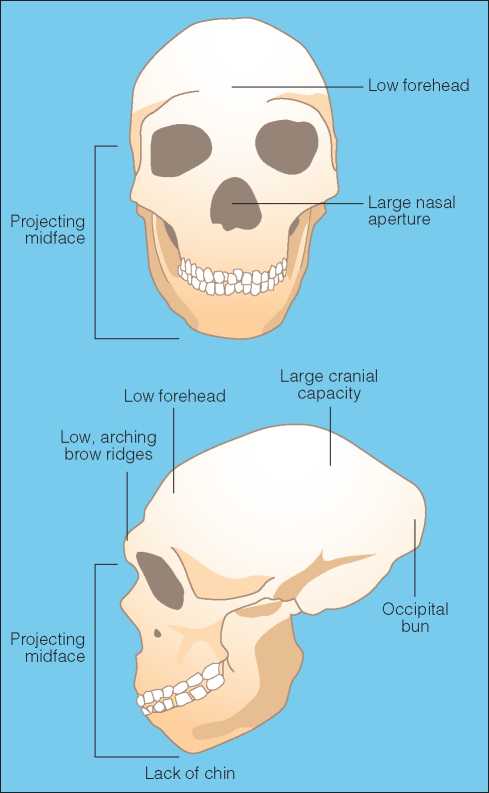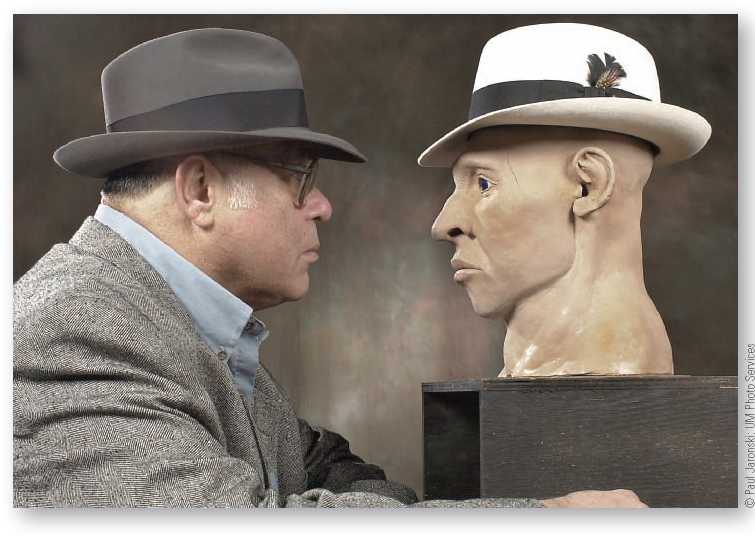Individual clad in animal skins and carrying a big club as he plods across the prehistoric landscape, perhaps dragging an unwilling female or a dead saber-toothed tiger. The stereotype has been perpetuated in novels and film. The popular image of Neandertals as brutish and incapable of spoken language, much less abstract or innovative thinking, may, in turn, have influenced the interpretation of the fossil and archaeological evidence. One of the most contentious issues in paleoanthropology today concerns whether the Neandertals represent an inferior side branch of human evolution that went extinct following the appearance of modern humans. Alternatively, descendents of the Neandertals may walk the earth today.
Neandertals were an extremely muscular people living from approximately 30,000 to 125,000 years ago in Europe and southwestern Asia. While having brains larger than the modern average size, Neandertals possessed faces distinctively different from those of modern humans. Their large noses and teeth projected forward. They had prominent bony brow ridges over their eyes. On the back of their skull, there was a bunlike bony mass for attachment of powerful neck muscles. These features, not in line with classic forms of Western beauty, may have contributed to the depiction of Neandertals as brutes. Their rude reputation may also derive from the timing of their discovery.
One of the first Neandertals was found in a cave in the Neander Valley (“tal” means “valley” in German, “thal” was the old, German spelling) near Dusseldorf, Germany, in 1856—well before scientific theories to account for human evolution had gained acceptance. (Darwin published On the Origins of Species by Means of Natural Selection three years later in 1859.)
Initially, experts were at a loss as to what to make of this discovery. Examination of the fossil skull, a few ribs, and some limb bones revealed that the individual was a human being, but it did not look “normal.” Some people believed the bones were those of a sickly and deformed contemporary. Others thought the skeleton belonged to a soldier who had succumbed to “water on the brain” during the Napoleonic Wars earlier that century. One prominent anatomist thought the remains were those of an idiot suffering from malnutrition, whose violent temper had gotten him into many fights, flattening his forehead and making his brow ridges bumpy. Similarly, an analysis of a skeleton found in 1908 near La Chapelle-aux-Saints in France mistakenly concluded that the specimen’s brain was apelike and that he walked like an ape.
The evidence indicates that Neandertals were nowhere near as brutish and apelike as originally portrayed, and some scholars now see them as the archaic H. sapiens of Europe and Southwest Asia, ancestral to
This early 20th-century portrayal of the La Chapelle-aux-Saints Neandertal, based on the research of French pa-leoanthropologist Marcellin Boule, makes a powerfully negative statement about the capabilities of this group as well as their distance from living humans. In looking at this sorry specimen, it is easy to forget that this portrayal is not derived directly from the fossil remains but from the collective imagination of early 20th-century Europeans. While paleoan-thropologists uniformly recognize the inaccuracies and biases present in this engraving, present-day reconstructions of Neandertals still vary tremendously and reflect the conflicting scientific theories and beliefs about their place in our evolutionary history.

The more derived, anatomically modern populations of these regions of the last 30,000 years. For example, paleoanthropologist C. Loring Brace observed that “classic” Neandertal features (Figure 8.10) are commonly present in 10,000-year-old skulls from Denmark and Norway.125
Nevertheless, Neandertals are somewhat distinctive when compared to more recent populations. Although they held modern-sized brains (average cranial capacity 1,400 cc versus 1,300 cc for modern H. sapiens), Nean-dertal skulls are notable for the protruding appearance of the midfacial region. The wear patterns on their large front teeth indicate that they may have been heavily used for tasks other than chewing. In many individuals, front teeth were worn down to the root stub by 35 to 40 years of age. The large noses of Neandertals probably were necessary to warm, moisten, and clean the dry, dusty frigid air of the glacial climate, preventing damage to the lungs and brain as seen in cold-adapted people of recent times. At the back of the skull, the bunlike bony mass providing attachment for the powerful neck muscles counteracted the weight of a heavy face.
All Neandertal fossils indicate that both sexes were muscular, with extremely robust and dense limb bones. Relative to body mass, the limbs were short (as they are in modern humans native to especially cold climates). Their shoulder blades indicate the importance of overarm and downward thrusting movements. Their arms

Figure 8.10 Features of the skull seen in “classic” Neandertals.
As this face-off between paleoanthropol-ogist Milford Wolpoff and his reconstruction of a Neandertal shows, the latter did not differ all that much from modern humans of European descent.

Were exceptionally powerful, and pronounced attachments on their hand bones attest to a remarkably strong grip. Science writer James Shreeve has suggested that a healthy Neandertal could lift an average North American football player over his head and throw him through the goalposts.126 Their massive, dense foot and leg bones suggest high levels of strength and endurance, comparable to robust individuals who live today.
Because brain size is related to overall body mass, heavy robust Neandertal bodies account for the large average size of the Neandertal brain. With H. habilis and H. erectus, increasing brain size has been linked to increasing cultural capabilities. Because Neandertal brain size falls at the high end of the human size range, pa-leoanthropologists shift to debating whether changes in the shape of the skull and skeleton are associated with changes in cultural capabilities.
Though the interpretation of Neandertal fossils has changed dramatically compared to when first discovered, they are still surrounded by controversy. Those who propose that the Neandertal line went extinct emphasize a notion of Neandertal biological difference and cultural inferiority. Those who include Neandertals in our direct ancestry emphasize the sophistication of Neandertal culture, attributing differences in skull shape and body form to regional adaptation to an extremely cold climate and the retention of ancestral traits in a somewhat isolated population.




 World History
World History

![Black Thursday [Illustrated Edition]](/uploads/posts/2015-05/1432470149_1431513568_003514b1_medium.jpeg)
![Stalingrad: The Most Vicious Battle of the War [History of the Second World War 38]](/uploads/posts/2015-05/1432581864_1425486471_part-38.jpeg)






